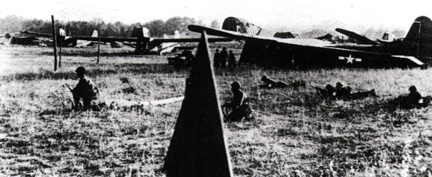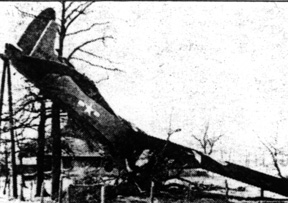|
in honor of Maj. Norman K. Arvidson
Attachment to Chapter 5 The O. H. Allen Story Information re the Selected quotations from a story by Ed Keys in the Lee G. Hampson of Modesto, CA, national chairman of the National World War II Glider Pilots Association paints a vivid picture of the glider pilots in action: “Imagine flying a flimsy, unarmed, fabric -covered CG-4A glider loaded with infantrymen, cartons of high explosive ammunition, gasoline and TNT at treetop level, through a murderous barrage of heavy flack to crash land in a tiny field surrounded by 80-foot trees, flooded and planted with big anti-glider poles and deadly land mines. “ Then, as you crawl out of the wreckage of your glider you are charged by big tanks and hostile enemy forces tossing hand grenades and firing small arms, mortar and machine gun fire at you. “Those were really thrilling and scary experiences. They were guaranteed to get your adrenaline pumping like mad. It’s like flying a stick of dynamite through the gates of hell.”
The huge 15-place CG-4A American combat glider had a plywood floor and was made of tubular steel covered with fabric. It was 48 feet and 4 inches long with a wingspan of 83 feet. It could carry a payload of 3,750 pounds. It was towed on a 1-inch diameter 300 foot nylon rope behind a C-47 transport plane. The CG-4A could land at about 50 miles an hour within as little as 200 feet when the pilot pushed it on to the skids under the nose. A total of 1,618 of the 1,899 American gliders used in Operation Market-Garden, the Allied invasion of Holland Sept. 17-30, 1944, got through to their landing zones behind German lines with 465 trailers, 710 jeeps, 2,856 tons of ammunition, gasoline and supplies. It was the largest armada of airborne troops in history. Among the 1,700 American glider pilots in the mission, 114 were casualties, with 12 killed, 65 missing and 37 injured or wounded. Casualties among the crews of the C-47s that carried the paratroopers and towed the gliders totaled 252, with 31 killed, 66 wounded or injured, and 155 missing or taken prisoner. The American airborne troops had 10,004 casualties, with 816 killed, 2,173 wounded or injured, and 7,015 missing or taken prisoner. On D-Day, June 6, 1944, American glider pilots were in the lead elements of Operation Overlord, the largest combined airborne and seaborne invasion in history. Over 1,200 CG-4A gliders dropped behind Nazi lines in France into their landing zones at points near Ste.-Mere-Eglise, Carentan and Caen, hauling in 95 howitzers, 290 vehicles, 238 tons of cargo and 4,021 men. Of the 1,030 U.S. glider pilots reaching Normandy, 180, or 17.5%, were casualties. Twenty-five were dead, 31 wounded, 91 injured and 33 missing or taken prisoner. On August 15, 1944, aa total of 372 CG-4As were towed from bases along the Italian coast to their landing zones in the Argens River Valley near LaMotte, France. The objective of that mission, code-named Operation Dragoon, was to cut off the German forces along the Mediterranean coast from those to the north in Normandy. The American gliders carried about 2,250 men, 25 howitzers and 166 vehicles. Eleven glider pilots were killed and 30 injured in crash landings in the hillside vineyards. More than 100 glider infantrymen were injured. On Dec. 24, 1944, American GPs in 12 CG-4As flew to the rescue in Bastogne, Belgium of the beleaguered 101st Airborne e Division whose commander Brig. Gen. Anthony C. McAuliffe responded with a defiant “Nuts” to the German demands that they surrender or be annihilated.
This glider was snagged in a tree after crash-landing at Wesel, Germany, after flying across the Rhine River in Operation Varsity on March 24, 1945. Thirty-five of the 50 gliders on a mission to Bastogne on Dec. 27 landed with 106,291 pounds of precious cargo. Fifteen of the glider pilots on that mission were either killed or captured when they landed in enemy territory.
The gigantic mission involved 906 CG-4As. A total of 140 of the 295 planes pulling them were hit and 12 C-47s crashed. A large percentage of the CG-4As landed on target and brought in 3,492 troops, 202 jeeps, 94 trailers and a great deal of ammunition and artillery. During Operation Broadway on March 5, 1945, 34 American gliders crash landed in hostile Burma jungles and 17 came in at Chowringhee hauling 478 men, three mules and a bulldozer to build sorely needed runways. Later, another 10 CG-4As went in to Myitkyina airport to rebuild the important runway there. Only six CG-4As and a single CG-13 were used in June, 1945, in a landing near Aparri in northern Luzon in the Philippines to carry in elements of the 11th Airborne Division. American glider pilots were scheduled for Operation Eclipse, the Allied offensive planned to capture Berlin, but this glory went to the Russians in April, 1945. They were spared from an aerial invasion of Japan when the atomic bomb was dropped on Hiroshima and Nagasaki. But the casualty rate among glider pilots in combat had already soared to 37%. Even glider pilot training was dangerous. In primary training, they were required to stop the engines of their airplanes while airborne and bring their light power planes in for deadstick landings. Stateside training accidents resulted in the loss of three to six gliders daily. Seventeen glidermen were killed and 162 more injured in training accidents between May, 1943 and February, 1944. Combat glider flying was far more traumatic and scary than that depicted in glider training films. Only 5,000 American glider pilots were among the 16 million American military personnel in World War II. They were all volunteers, cocky, tough and not at all reticent about letting anyone know that the letter “G” on the silver wings stood for “Guts.” A 101st Airborne Division historian described them as “the most uninhibited individuals in the Army. There seemed to be something about flying a glider that freed a man from the ordinary restraints of Army life. They successfully defied all attempts at organization. End of Attachment to Chapter 5 — Return to Chapter 5
Cover — Introduction — Table of Contents Chapter — 01 — 02 — 03 — 04 — 05 — 06 — 07 — 08 — 09 — 10 Or Go To Or |
|||||||||

